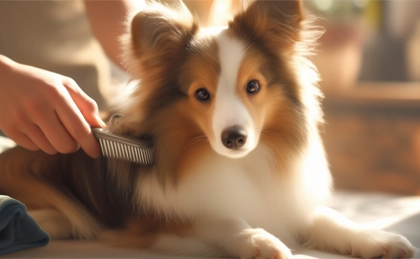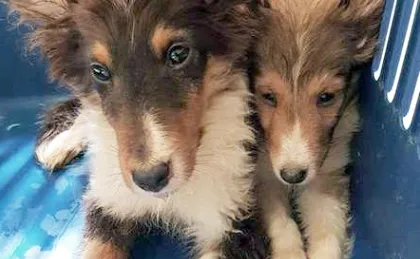How to Socialize a Shy Sheltie
As a somewhat submissive breed, Shelties can shy dogs if they aren't well socialized as puppies. Missing this window is a huge loss for a Sheltie, but there are still some ways to help boost his confidence in adulthood.

Piper demonstrates how Shelties can be very shy dogs.
While breeders aim to produce self-assured, confident Shelties, there is no denying that sometimes these can be very shy dogs. This is usually a result of poor socialization when they're young, mixed in with genetic susceptibilities.
With the wrong mix of genes and environment, some Shetland Sheepdogs can grow up to be extremely nervous of strangers and novel stimuli.
But it doesn't have to be this way. While breeders should take every measure to avoid producing nervous puppies, it's our job as pet owners to socialize our Shelties early on. It's doesn't take much effort—and seriously boosts their confidence for the rest of their lives.
What Does Sheltie Shyness Look Like?
We first met Piper Woofington Moon when he was nine months old, which is well past the ideal window for socializing puppies. He'd spent his formative months as a kennel dog, getting lots of playtime with other dogs but not as much human socialization as a pet dog.
When we met Piper, his shyness and anxiety were immediately apparent:
- His ears went back and he lowered his head
- He crouched on the ground in a tight ball
- He flinched when our hands approached for a pat
- He tensed his while body when being picked up
These are all typical traits of shy dogs who haven't had sufficient variety of exposure to new people and environments. As adults, any kind of novelty incites fear instead of excitement about experiencing something new.
We were very careful with Piper over the next few months as we tried to help him overcome his shyness. His confidence improved a little as the unfamiliar became familiar. But he was never able to be as outgoing as his half-brother, Howard, who was fully immersed in our human world from a young age.
What's more, his confidence ebbed at difficult times in his life. When Howard passed, Piper lost his bold counterpart and began to fall back into his nervous instincts. I can't stress the need to expose young dogs to a broad range of novel situations. It dictates how they react to the world for the rest of their lives.
How to Socialize a Puppy
The best time to socialize your puppy is between 8 and 16 weeks old. After that, the window for socialization closes and it's much harder to influence your dog's underlying attitude and behavior.

Socialize your puppy from day one.
Studies also show that puppies who don't receive enough contact during 5-12 weeks of age can never react normally with humans again. This is an extremely sensitive period of a dog's life and is also when they form their strongest bonds.
Here are my tips on socializing puppies from 8 weeks old:
1. At home
When you bring your puppy home, safely allow them to explore the whole house, with all the different textures (eg, floors), sounds (eg, music), and smells (eg, cleaning products). Over the coming weeks, you want your Sheltie to become familiar with all types of stimuli in her home environment.
2. In town
Take your Sheltie puppy to the coffee shop, walk through the town, and allow strangers to stroke her and offer treats. There will be lots of new sounds, smells, and sensations for your Sheltie, but she will be completely safe under your protection.
3. On the street
Fast or loud vehicles can be terrifying to shy dogs. So display the opposite reaction when they zip past. When a bus goes by, make silly excitable noises, offer treats, and generally act happy rather than concerned. This will help direct her away from a fear response. Watch her closely. It's ok for her to be cautious at first, but her curious puppy nature will soon kick in as she embraces the novelty.
4. Meeting people
Socializing puppies with humans is easy, as long as no-one mishandles her. Take your Sheltie to a gathering of friends and family and let everyone take their time to say hello. Try to not overwhelm your Sheltie all at once though. Let her meet everyone over a period of at least 30 minutes and preferably a couple of hours. There will be lots of different voices, personalities, and behaviors for your little dog to assimilate as normal.
5. Meeting other dogs
Unless she came from a puppy mill, your Sheltie had lots of positive exposure to her littermates from birth to 8 weeks. Continue socializing her with other dogs in a controlled environment, so she learns that different dogs come in all kinds of sizes, ages, and temperaments. Your puppy can meet other dogs after her second set of vaccinations, and will benefit from experiences like puppy school and playtime with friendly dogs.

Our Shelties got along together from day one.
How to Socialize a Shy Adult Sheltie
Shy dogs are fearful of almost anyone and anything new. Their genetic instincts along with their lack of early experiences as a puppy create an automatic stress reaction. Your job is to gradually overwrite this fear response by giving her lots of positive experiences.
When socializing a shy adult dog, the principles are the same as socializing a puppy, but you're going to take everything a lot slower. For instance:
1. Meeting people at home
When your Sheltie is afraid of a house guest, tell that person to move well away and completely ignore your dog. Then approach that person yourself and act friendly and jolly. This models the correct response and your dog can see nothing bad happens.
Give your Sheltie some time to accept the person's presence in her home. Once she starts to relax, you'll see her sit or lay down at a safe distance and just monitor the situation. Place a few treats on the ground to lure your Sheltie a little closer.
If she takes the bait, have your willing guest crouch down low and relax on the ground without making eye contact. If they're really keen to get to know your Sheltie, they can lie on their back on the floor to show total they're totally non-threatening.
Your shy dog will be curious, but may be fighting an internal battle of whether to investigate this potential play partner or keep a safe distance. Give her time and don't force any kind of interaction.
When your Sheltie does approach, praise and reward her in a calm tone. Encourage her to sniff your guest. They can offer her treats directly, and take this opportunity to rub her chest. They should avoid patting the top of her hear head as this can be threatening to a nervous Sheltie.
Once your Sheltie has the chance to investigate and interact with your guest, each subsequent meeting should get a little easier. They may even become friends for life. You can repeat process with all house guests. Bear in mind that your Sheltie will take longer to accept dominant people who don't tone down their voice and demeanor.
2. Meeting other dogs
This is a bit trickier because you can't predict the behavior of other dogs. Ideally, find a friend who has a dog with a reliably gentle and submissive personality. It can be a big dog—in fact, you'll often find that very small dogs like Terriers can be more snappy and unpredictable, while large mountain dogs or sheepdogs are gentle giants.
Introduce both dogs in a neutral territory (so neither one is the invader) and off the leash (so neither is restricted). Aim to give your Sheltie will have the opportunity to approach the other dog in her own time and sniff all the necessary places. This is a much better experience than a dominant dog running in and catching your Sheltie off guard.
Final Thoughts
Although he was once terrified of new people, Piper has come to accept a number of house guests coming and going. Routine exposure means he even settles into large gatherings.
He's also come to accept children in certain situations, allowing them to pat him on our walks. His sensitivity was beautiful when it came to introducing him to our newborn babies. However, he still struggles with children running and screaming, and for some years his response was to herd them and nip at their heels. In these situations, we put him on a leash and remove him from the perceived chaos.
Yet when we were home alone, Piper was just as relaxed as Howard. This shows how even extremely shy dogs can feel comfortable around their trusted people. And if they can feel this relaxed with us, then they can feel this relaxed around other people, given enough time and encouragement.

As an adult Sheltie, Piper found his confidence in some novel situations.

How to Groom a Shetland Sheepdog
Shetland Sheepdogs have luxurious double coats, which come with the responsibility of routine grooming. Here's my step-by-step guide to de-shedding the undercoat.

The Best Grooming Tools for Shelties
The Shetland Sheepdog's double coat demands 3 specialized dog brushes: a detangling and de-shedding comb, a fine-toothed comb for knots, and a slicker brush for finishing.

How To Photograph Your Dog
These are my top ten tips on photographing your dog, from choosing the perfect setting and camera angle, to being patient and capturing your pet in the moment.

Find Sheltie Puppies for Sale
Find Sheltie puppies near you with our extensive directory of ethical Shetland Sheepdog breeders in the USA, Canada, the UK, Australia, and New Zealand.

How to Clicker Train Your Sheltie
Clicker training is ideal for Shelties learning obedience, tricks, and agility. It's a gentle training method that uses psychological conditioning.

6 Warning Signs of a Puppy Mill
Puppy mills are large-scale breeding operations. These inhumane farms produce traumatized dogs, vulnerable to infectious and genetic diseases.

Caring for Your Sheltie's Health
Take care of your Shetland Sheepdog's health by learning about grooming, diet, exercise, oral health, genetic disorders, de-sexing, and vaccinations.

Saved From The Dog Meat Trade
This particular group of Collies and Shelties broke my heart because as we know, these breeds are especially sensitive, gentle, and intelligent dogs.
